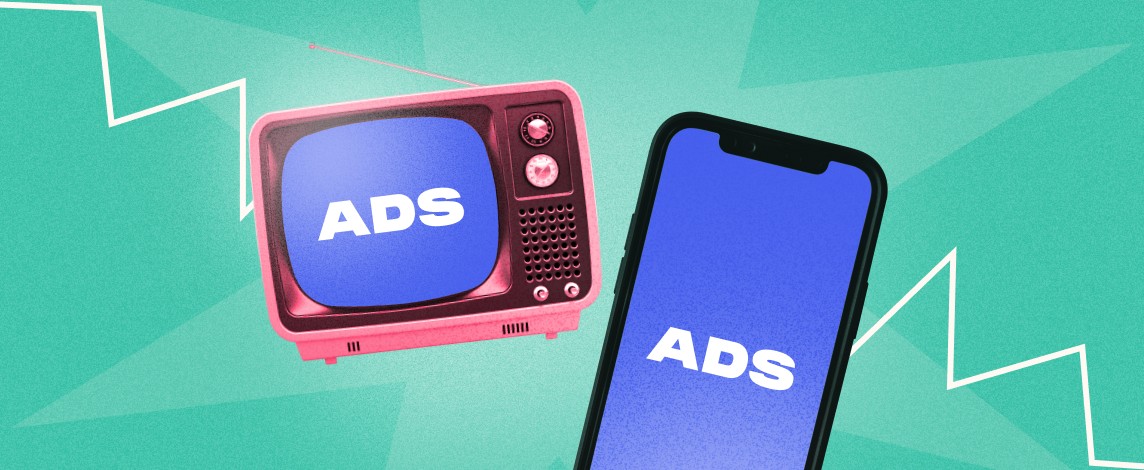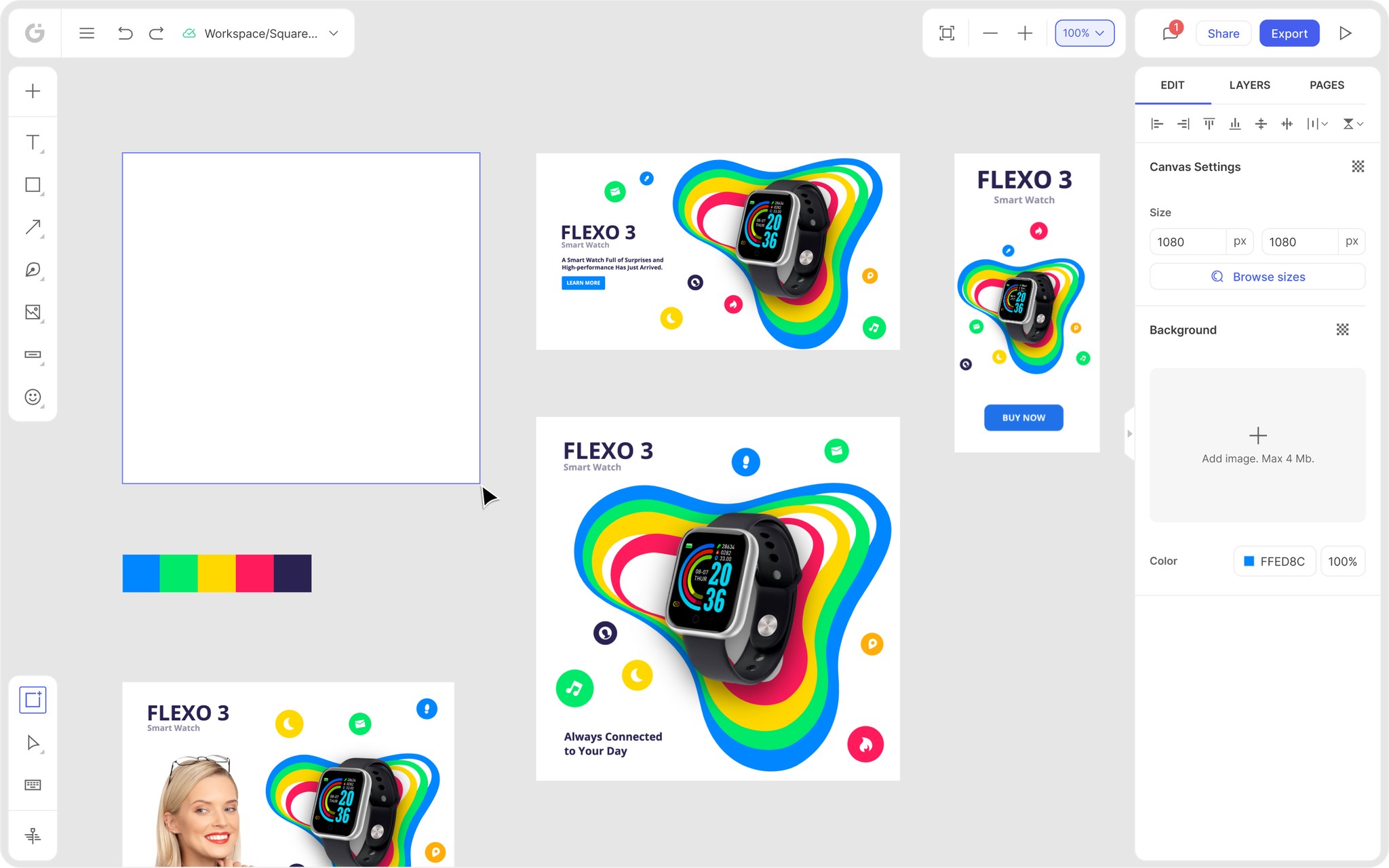Discover the essence of Amazon Storefront banners and their pivotal role in captivating potential customers. Learn the optimal size – 3000 pixels wide by 600 pixels tall – for seamless integration and stunning visual impact. Uncover expert tips for crafting compelling banners that reflect your brand identity and drive sales
Posted Nov 9, 2022
•
11 min read

Graphic design, Marketing

Create beautiful marketing graphics at scale.
Video Advertising Evolution: From TV to Mobile Devices
The first TV commercial:1941
Back in the month of May 1941, the FCC (Federal Communications Commission) had licensed their first-ever first commercial in the U.S. that is chargeable all across the TV networks. It was aired on July 1st on the NBC-owned WNBT that chose to display advertising right before a baseball game that happened between the Brooklyn Dodgers and the Philadelphia Phillies.
This very first digital advertising 10-second spot cost the New York-based Bulova Watch Co. only $9 that equates to roughly $157 now. The advertisers had advertised the image of a Bulova clock that was superimposed over the map of the United States. as a resemblance of “America runs on Bulova time,” announced by the voiceover artist to its viewers. This ad was viewed only by around 4,000 people, as only a few U.S. households on the East Coast owned a set back then. Accounting on this user experience, Bulova quickly revolutionized the complete spot of the advertisement which was followed by the other companies too.

In spite of it all, it was only after World War II, the TV commercial speeded up, that is between 1949 and 1951, where video ad spend increased from $12.3 million to $128 million. And by 1954, it became the leading medium for advertising that reached its peak of about 90% in the year 1960.
The Golden Age of TV ads: 1950s-60s
Between 1945 and 1964 the Baby Boom created a new age of consumerism that was caused by the pent-up demand of the wartime. With the reach of the coast-to-coast transmission in 1951, the commercials stretch out to everything, from essential consumer goods to automobiles, making their way into American households. The advertisers advertised ads that often depicted traditional family values by showing the idealized modern family coming together and animations like the Ajax Pixies, and catchy jingles, the ones for Alka Seltzer and Oscar Meyer that turned out extremely popular in this golden period of this time.
Till the 60s, television programs were advertiser-sponsored, which meant that brands had complete creative control over the shows they were producing and could even block competition from advertising during their broadcast.

Even the names of these TV ads were promoted by the sponsors as the cost of the programming increased drastically that later caused the TV advertising to switch over to participating sponsorships. From now on, these advertisers were now buying the TV commercial slots from the inventory that were available by the TV networks.
With time, the slots became competitive leading to the increase of the cost per slot that marked the peak of this trend, observed each year during the most-watched TV broadcasting event, called the Super Bowl.
A rise in the Super Bowl Commercials: 1980s
Most people agree that the Super Bowl commercials came to full potential in the 80s for the first time, particularly the Apple’s 1984 Macintosh ad. This commercial was inspired by George Orwell’s dystopian novel and was directed by Ridley Scott who is known for his movies like “Alien” and “Blade Runner,” costing it $500,000 to make, which is about ten times more than what Apple had spent at the time the ad paid off.
According to the agency, Chiat/Day, the commercial had earned Apple roughly about $45 million in free advertising from TV stations covering and playing it. In the 2019 survey, it was said that 20% of people watched the Super Bowl only for the commercials.
The evolution of online advertising: 1994
The first-ever online banner ad that was displayed was back in the year 1994, October. It was displayed on the first web magazine, HotWired Wired.com with AT&T paying about $30,000 to display the banner on its website for three months. It had dared their online visitors to click on the banner saying, “Have you ever clicked your mouse right here? You will,” and the strategy worked with the ad enjoyed by an unbelievable click-through-rate of 44%.
This was when the marketers had realized that online advertising banner ads on the internet could give them what the TV couldn’t, a target audience!
With Google AdWords launching in the year 2000, it became possible for internet users to browse based on their search history. And, in the year 2004, Facebook collected vast amounts of data from its users that in return gave the advertisers unprecedented insight into the consumers’ behavior and interests to work on.
The mobile video launch via YouTube: 2005
With this worldwide loved platform to date, the users could incorporate their user video consumption that was available to them via YouTube, making it tremendously successful. This mobile-first video experience had reached over 100 million per day views in just a gap of a single year. 2006 also became a year when the website introduced its participatory video media advertising, displayed in the upper right-hand corner of the homepage that played with the click of the user. YouTube had acquired a whopping $1.65 billion from google with other ad formats being introduced to the platform.

In the year 2007, YouTube added their video ads and partner program that allowed the creators to monetize eligible content, and by November 2008, pre-roll ads started playing before a few YouTube videos.
At present, YouTube offers many types of video advertising formats, that include:
Skippable in-stream ads: These are ads that appear before, during, or after videos, that are skippable after five seconds of viewing. And if the ad is viewed for more than 30 seconds, the advertiser is charged by Google.
Non-skippable in-stream ads: These are ads that are 15-second long and are played before the main video and can’t be skipped. They are accompanied by a countdown box too.
Discovery Ads: These are ads that appear in the video suggestions placed on the right side of the player or via the specific keywords used by the user on the platform. Here, the advertiser is charged each time a user clicks on the ad.
Bumper ads: These are 6 second quick ads that appear before and are unskippable, and sold on the basis of a CPM.
Evolution of video advertising from TV commercials to the mobile age: 2007
Just like the entering of TV ads got videos into every home, the evolution of the smartphone allowed marketers to reach people anytime and anywhere unlike the newspaper ad. With the launch of the first iPhone in 2007 that was widely regarded as the first modern smartphone, scrolling through the internet wasn’t tedious and costly. This medium allowed access to all websites in a mobile version.
Although the marketing plan was still far from what it is today with the features, it offered a bigger screen with Apple’s Safari internet browser, a YouTube app, and of course, better internet connectivity.
Fun fact – At the beginning of last year, about 50% of all the video ads were viewed on mobile, that is, 40% higher since 2018. Now, the U.S. mobile video ad is spending to keep it rising year-over-year, aiming at nearly $25 billion in 2022.
There is a catch, this mobile video ad, and its newfound reach came with a twist, here is how,
With the charge people got over what they were watching, the attention spans of the viewers for these advertisements shrunk considerably. For instance, mobile video news feed video ads are now watched being watched on an average of 5.7 seconds. This made it quite clear that a 30-second spot that worked on TV couldn’t survive online and the video marketers would now be required to create impressive, engaging, short-form content instead.
The boost of video consumption:2013 to Present
In the year 2013, the video content started to explode online between the consumers and social media companies wanting their part. Now, there are more major companies with their capabilities on these platforms or on their video platforms.
The best part of it all is that it is just the start with more and more platforms coming into being, taking over the world. Here are a few mentions:
Flourishing media platforms: 2013
1) Vine
We’re sure you’ve heard of it! In 2013, it became a platform that was owned by Twitter and took over the internet without a 6-second. This is where the most viral videos were captured, made by the audiences or viewed, bursting into good laughter.
This indeed gave reason to most mobile device users to create video content on vines like “Yass Cat,” “Why You Always Lying,” “Duck Army,” and “Who Is She?” that garnered millions of loops and are still remembered.
Unfortunately, It couldn’t capture much attention and wasn’t with the marketers as the platform went against monetization and disruptive mobile advertising. It perhaps denied advertisers from paying for placement similar to promoted Tweets. But instead, it agreed to turn as a middleman between brands and content creators.
The success of vine was short and short-lived and quickly faded away, shutting down in 2016.

2)Snapchat
Snapchat introduced video capacity by late 2012/early 2013 that allowed the users to send 10-second videos to each other that got deleted after 24 hours on its own.
With this addition in its technology, its mobile marketing initiatives rose to fame with the brands finding more video advertising opportunities here:
In 2013 the stories could get posted by users and the companies got to post threads of vertical snaps that disappeared after 24 hours.
In 2014, Snapchat considered its first shot at advertising, allowing sponsored ads that appeared in the feed of the user.
In 2015, a new page was accessible that featured content from news, entertainment, lifestyle, as well as other industries.
In 2016 the video ads technology appeared between the stories of the friends.
At present, the pace of Snapchat boasts about 14 billion daily video views aged between 18 and 24. Irrespective of it not gaining as much attention as it used to, the platform gives the marketers a chance to engage with the younger demographic via short-form videos.

3) Instagram
As popular as it is even now, Instagram marked yet another milestone in 2013 by introducing a 15-second video capacity on Instagram. This came along with 13 filters for videos that were as successful as the photos. At present, it allows a large variety, similar to the parent company including:
Stories ads that appear on Instagram’s Stories.
In-feed video ads that are 120-second-long ads viewed in square or landscape format. It appears on users’ feeds.
Carousel ads that can be swiped by users to view up to ten images or videos.
Collection ads that view on collages of one main image or video. They can be easily connected to the brand’s site or product pages brand.
The explore ads that appear in Instagram’s Explore tab.

4) Facebook
Facebook became the first video-oriented platform in 2013 by introducing its in-feed autoplay feature. It is the second most popular platform used to watch videos after YouTube. Facebook enables:
Slideshows that make it possible to turn images and text into a video ad.
Playables that are interactive previews of gaming apps.
Instant Experiences of a full-screen video ad experience.

5) TikTok
This mobile video app was launched in 2016 allowing users to create and post short videos. It featured lip-sync, music, dance, comedy moments, more that made it possible for the consumers hooked to their devices.
The trends made it possible for TikTok to grow quickly with a pace of 800 million active monthly users, surpassing the rate of Reddit, Snapchat, Twitter, and Pinterest. This mobile video app includes:
In-Feed Video that appears in the feed of the user.
The advertisers took over via their brands on the users’ screen as they opened the app.
The hashtag Challenge formats were added as they appeared on the discovery page of the users’ news feeds, encouraging them to participate in creative challenges.
Branded AR content included lenses, stickers, and other filters in videos.
Just like Snapchat, TikTok also caters to a younger audience of 63.5% under 29.

Video advertising account as per 2020
With the massive increase in the viewers or consumers, it is undeniable that the advertising video battles for engaging online content also observed monetary with each brand willing to invest in these advertisements. Here are the essentials of the product:
YouTube is known to be the most effective video marketing platform with 78.8% of marketers. The second in the row being Facebook with 58.5%.
With $10.35 billion, video ad spends on social media accounts for 28.7% of the total global and is expected to double.
28% of video marketers plan to incorporate IGTV as a part of their video marketing strategy.
Tweets are getting 10x more engagement compared to without a video saving more than 50% on cost-per-engagement (CPE).
Approximately, 1.5 consumers are likely to watch videos on mobile phones compared to their desktops.
That’s all folks! This is the evolution of our very own advertising, from TV, mobile-first SMS uses, to straight rights reserved advertisements. Also, if you are looking for video editing software tools in 2021,
To Conclude:
The rise in digital media has for sure taken over television with a decrease for the first time in 2017 and 2018 with the high increase in the download trend. Without a doubt, the future lies with OTT advertising that delivers directly to the users over the internet be it on smart TVs, computers, mobile phones.
Video Advertising Evolution: From TV to Mobile Devices FAQs
1. What was the very first TV commercial?
The first-ever commercial was aired 75 years ago that cost only $9, on July 1, 1941, at 2:29 p.m in the US. It was a 10-second ad for Bulova, a New York-based watch company that telecasted the ad right before a Brooklyn Dodgers and Philadelphia Phillies baseball game.
2. How does advertising influence teenagers?
Unfortunately, even though the ads feed on the sales of youngsters, they are harmful to children with a negative impact on the mental and the physical health of the children. However, using a level that is acceptable and healthy works well for all.
3. How was advertising done in the olden times?
Advertisers in the ancient and medieval world had no ad spending and the content of the brands took place by word of mouth. Later by the 17th century, the advertisers moved to news headlines of the newspapers in London that flourished later by the 18th century.
Features
Explore templates
Alternatives
© 2024 Glorify App - All rights reserved














